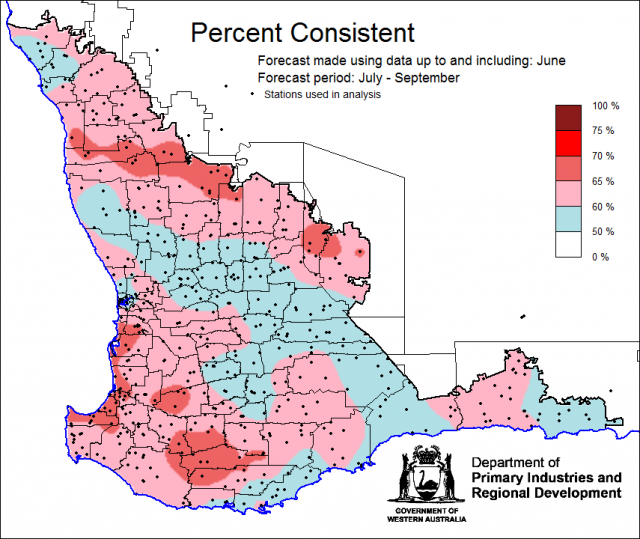Summary
The Department of Primary Industries and Regional Development’s (DPIRD) Statistical Seasonal Forecast (SSF) outlook for July to September is neutral (40-60%) chance of exceeding median rainfall, with higher (70-80%) odds in the south and parts of the north and eastern grainbelt. The July to October 2020 outlook is also close to neutral odds.
- For July to September, the SSF is indicating neutral (40-60%) chance of exceeding median rainfall, with higher (70-80%) odds in the south and parts of the north and eastern grainbelt. The most probable rainfall decile map indicates decile 8-9 for most of the SWLD, with decile 4-7 elsewhere. Predictive skill based on June conditions is poor to moderate (50-70% consistent).
- For July to October, the SSF is close to neutral (40-60%), with higher chances of exceeding median rainfall for parts of the north, east and southern grainbelt. The most probable rainfall decile map indicates decile 8-9 for the majority of the SWLD, with decile 4-7 elsewhere. Predictive skill based on June conditions is poor to moderate (50-70% consistent).
- The Bureau of Meteorology’s current seasonal outlook is indicating close to neutral chances 45-60% of exceeding median rainfall for July to September 2020. Predictive skill is poor to good (45-75% consistent). The longer-term outlook for August to October is mostly neutral, with slightly higher chances (60-65%) of a wetter 3-months in the far north. Predictive skill is 50-75% consistent.
- Temperature outlooks for July to September 2020, from the Bureau indicate a 65-80% chance of above average day-time maxima (skill 55-75%) and 70-80% chance of above average night-time minima (skill mostly low to very low below 55%) for the SWLD.
- June rainfall was generally average in the SWLD, and below average in the South Coastal and South East Coastal Districts.June maximum temperatures were above average to very much above average, and highest on record for the whole of Western Australia. June minimum temperatures were above average.
- Cooling Sea Surface Temperatures in the Indian Ocean north of Australia and higher than normal atmospheric pressure over Australia are currently the most dominant climate drivers. This reduces rainfall.
Three Month Outlook for the south-west of Western Australia
Statistical Seasonal Forecasting (SSF)
DPIRD’s Statistical Seasonal Forecast (SSF) system uses historical relationships between global sea surface temperature and sea level pressure with rainfall in south-west Australia to produce forecasts of rainfall for the coming months. Users can click on any station indicated on the map for location-specific forecast information from the Seasonal Climate Information web page.
For July to September, the SSF is indicating neutral 40-60% chance of exceeding median rainfall, with higher odds in the south and parts of the north and eastern grainbelt. The most probable rainfall decile map indicates decile 8-9 for the majority of the SWLD, with decile 4-7 elsewhere. Predictive skill based on June conditions is poor to moderate (50-70% consistent).


